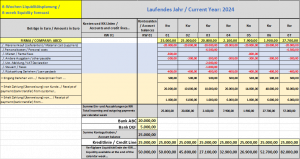Newsletter Diciembre 2023:
By: Paloma Alcaide
Effective Liquidity Planning
Liquidity planning is a crucial aspect of financial management that involves assessing and managing an organisation’s ability to meet short-term financial obligations.
Effective liquidity planning ensures that an organisation can manage its ongoing operational expenses, debts and unforeseen financial challenges.
This guide will look at the intricacies of effective liquidity planning, exploring the key components and providing a comprehensive overview of the process to meet short-term financial challenges with confidence and foresight.
1. Understanding liquidity planning:
Liquidity refers to a company’s ability to quickly convert its assets into cash without incurring significant losses. While liquidity is critical for short-term financial stability, excessive liquidity can lead to underutilised resources. Finding the right balance is critical! The first step in liquidity planning is to understand the components of liquidity:
- Current assets: These include cash, receivables and short-term investments. Evaluate the liquidity of each asset and its conversion period.
- Current liabilities: Identify current liabilities such as accounts payable, short-term loans and other current liabilities.
- Working capital: Calculate working capital, which is the difference between current assets and current liabilities. A positive working capital indicates short-term solvency.
2. Strategies for forecasting cash flows:
Accurate cash flow forecasting is the foundation of effective liquidity planning.
- Incoming and outgoing payments: Consider both cash receipts and cash payments.
- Sales: Forecast sales based on historical data, market trends and sales funnels.
- Receivables: Estimate and monitor the timing of customer payments.
- Operating Expenses: Forecast monthly expenses, including rent, utilities, salaries and variable costs.
- Debt service: Factor in loan repayments and interest payments.
- Contingencies: Plan for unforeseen expenses by maintaining a buffer fund.
2a. Strategies for optimizing working capital management:
Efficient working capital management improves liquidity. Consider the following strategies:
- Inventory management: Maintain optimal inventory levels to avoid excess capital in unsold goods.
- Receivables management: Implement efficient credit policies and monitor customer payments to reduce average accounts receivable turnover times.
- Payables: Negotiate favourable payment terms with suppliers to optimise cash flow
3. Establish a liquidity buffer:
Create a liquidity buffer to mitigate unforeseen challenges.
This can be achieved through the following measures:
- Cash reserves: set aside a portion of cash for emergencies and to protect against unforeseen events or opportunities.
- Lines of credit: Establish a line of credit as an additional layer of protection and to access funds when needed.
- Trade favourable credit terms to improve liquidity options.
- Continuous monitoring by regularly monitoring and adjusting liquidity plans for a prompt response to changing market conditions.
4. Conclusion:
In the business world, effective liquidity planning is not just a task; it is a strategic imperative.
This guide provides companies with insights into the knowledge and tools they need to strengthen their financial foundations, promote resilience and be ready in times of uncertainty.
By understanding, optimising, and adapting, companies can proactively manage liquidity to not only survive, but thrive in challenging times.
Liquidity planning is not a one-off task, but an ongoing process.
Regularly monitor actual cash flows against forecasts and adjusting the plan if necessary.
This dynamic approach ensures adaptability to changing market conditions and business circumstances.
Effective liquidity planning is critical to a company’s short-term financial health and overall stability.
By understanding the components of liquidity, forecasting cash flows, optimising working capital management, building a cash buffer and regularly monitoring and adjusting, companies can manage economic uncertainty and take advantage of opportunities.
A solid liquidity plan contributes to financial resilience and lays the foundation for long-term success.
Example of weekly liquidity planning
At bdp Mechanical Components, we are your partner in outsourcing mechanical components. We can streamline your operations with our outsourcing solutions, maximize your production and provide efficiency and quality in every component. Come and experience with us the benefits of outsourcing your mechanical components and take the hassle out of component production.
We offer you a comprehensive range of services, including procurement, supplier audits, process audits, product inspections, and logistics support. Rest assured that bdp Mechanical Components is committed to providing you with a seamless and efficient experience throughout our collaboration.
Feel free to contact us at purchase@bdp-mc.com with any further questions you may have regarding outsourcing of mechanical components.
Our bdp Mechanical Components team will be happy to advise and support you.



